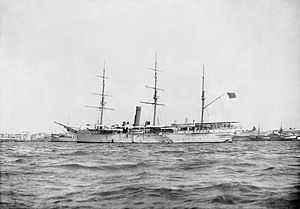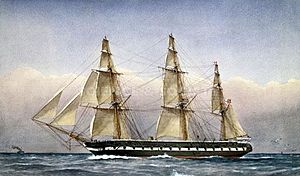HHS Glasgow facts for kids
class="infobox " style="float: right; clear: right; width: 315px; border-spacing: 2px; text-align: left; font-size: 90%;"
| colspan="2" style="text-align: center; font-size: 90%; line-height: 1.5em;" | 
|} His Highness' Ship Glasgowwas a special boat called a royal yacht. It belonged to the Sultan of Zanzibar, who was like a king. This fancy ship was built to look like a big British warship that the Sultan had seen. The Glasgowcost a lot of money, about £32,735. It had many luxurious features inside. However, the Sultan was not very impressed with it. So, the ship mostly stayed docked in the harbour at Zanzibar Town for many years. In 1896, the Glasgowwas used in a short conflict called the Anglo-Zanzibar War. It was quickly sunk by British warships. The ship's wreck stayed in the harbour, with its masts and funnel sticking out of the water. It was finally taken apart for scrap metal in 1912.
Contents
| History | |
|---|---|
| Name | Glasgow |
| Operator | Sultan of Zanzibar |
| Builder | William Denny and Brothers |
| Yard number | Hull 200 |
| Laid down | 14 May 1877 |
| Launched | 2 March 1878 |
| Out of service | 27 August 1896 |
| Fate | Sunk during Anglo-Zanzibar War, salvaged and broken up 1912 |
| General characteristics | |
| Type | Royal yacht |
| Displacement | 1,416 tons |
| Length | 210 ft (64 m) |
| Beam | 29 ft (8.8 m) |
| Draft | 16 ft (4.9 m) |
| Installed power | 172 nhp |
| Propulsion | Single compound steam engine with two bladed lifting propeller |
| Speed | 12 knots (22 km/h; 14 mph) |
| Armament | 7 x RML 9-pounder 9-barrel Gatling gun |
Building the Royal Yacht Glasgow
The Glasgow was built in 1878. It was meant to replace the ships that Sultan Bargash had lost in a hurricane in 1872. The Sultan wanted his new ship to be like the British Royal Navy warship HMS Glasgow. He had been very impressed when that ship visited Zanzibar in 1873.
Sultan Bargash asked Sir William Mackinnon for advice. Sir William suggested a company called William Denny and Brothers to build the ship. On May 14, 1877, work began on the Glasgow.
The ship was built with a strong iron frame. It had teak wood planks and a keel made from rock elm. The bottom of the hull was covered with a special metal called Muntz metal. The Glasgow had three masts for sails and a steam engine to power it. It also had a propeller that could be lifted out of the water. The ship was officially launched on March 2, 1878.
Luxury Features and Armament
As a royal yacht, the Glasgow was very well-equipped. It had two special rooms for the Sultan, a dining room, a bathroom, and a toilet. The total cost of the ship was £32,735.
The ship was also armed for defense. It had seven cannons that fired nine-pound shells. It also had a nine-barrelled Gatling gun, which was a gift from Queen Victoria.
The Glasgow sailed from Portsmouth to Zanzibar on April 17, 1878. Captain Hand of the Royal Navy was in command. When the ship arrived in Zanzibar Town, the Sultan inspected it. However, he was reportedly not very impressed. He thought his new ship was not as grand as the British warship it was named after. Because of this, the Glasgow mostly stayed anchored in the harbour until 1896.
The Anglo-Zanzibar War
On August 25, 1896, a new Sultan named Khalid took power. He did this without asking the British authorities first, which was against a treaty. This led to a very short conflict known as the Anglo-Zanzibar War.
On August 27, the old Glasgow was the only ship the Zanzibar Navy had. It fired its guns at five British ships. These ships were led by the cruiser HMS St George, which had powerful guns.
The Sinking of Glasgow
In return, the Glasgow was hit below its waterline and began to sink. Its crew quickly raised the British flag as a sign of surrender. British sailors rescued everyone on board using small boats. The ship finally sank at 10:45 am that day. It settled on the harbour bed, with only its masts and funnel sticking out of the water.
The Glasgow stayed sunk in the harbour for many years. Eventually, one of its masts became unstable. The harbour master and the Zanzibar government decided it was time to remove the wreck. In 1912, a company was hired to salvage the ship for £2,500.
The ship was broken up using explosives over six months. The pieces were then dumped into the sea. The ship's boiler, propeller, and some cannons were sold for scrap metal. Today, parts of the iron frame, teak planks, and pieces of the engine can still be found on the harbour bed. Sometimes, divers visit the site.



